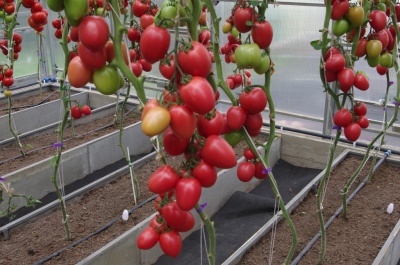
- Authors: Blokin-Mechtalin Vasily Ivanovich
- Year of approval: 2020
- Category: hybrid
- Growth type: indeterminate
- Appointment: fresh consumption, for pickling and canning, for ketchup and tomato paste
- Ripening period: early
- Ripening time, days: 95-100
- Growing conditions: for open ground, for film greenhouses
- Marketability: high
- Transportability: high
The newest varieties of tomatoes, despite their small popularity so far, deserve every attention. The Camelot tomato is a good example of this. It's time to familiarize yourself with it in more detail.
Breeding history
The Camelot tomato was introduced in 2020. Its developer is a well-known specialist - Blokin-Mechtalin. It is worth emphasizing that this is a hybrid, but the sources of hybridization have not been disclosed.
Description of the variety
Camelot belongs to the indeterminate varieties of tomatoes. Its bushes are distinguished by strong growth. A moderately large number of leaves will appear on the branches of the tomato. They are characterized by a dark green color. Remarkably, the foliage is long, and this property is not very typical for ordinary tomatoes.
The main qualities of the fruit
All unripe berries of Camelot have a light green color. When they are ripe, they will take on a raspberry color. In shape, the tomato is similar to a cube and has weakly pronounced ribs. 6, 7 or 8 tomatoes can be formed on 1 brush. Other typical features are stalk articulation and high keeping quality.
Taste characteristics
Camelot feels pretty good. Its pulp is pleasantly firm. Another attractive property is meatiness. Therefore, the tasting assessment of the culture will be high.
Ripening and fruiting
The Camelot tomato belongs to the early group of varieties. Between the formation of the shoots and the achievement of the readiness of the crop, it takes an average of 95-100 days. The exact time depends on a number of factors. If the plant begins to bear fruit, it will yield for a long time. Usually, the first berries are removed in mid-July, and this process ends only with the first frost.
Yield
The productivity of this variety is high. It can reach 13-14 kg per 1 sq. m. It is important to emphasize that the marketability of the crop is also high. In the right hands, the beds of such a tomato can yield a very high-quality harvest.
The timing of planting seedlings and planting in the ground
It is necessary to start seedlings in early or mid-April. The specific term is determined by the gardeners themselves. Normally, they take into account both the peculiarities of the climate and the immediate current weather. It is necessary to pay attention to the warming up of the soil. For planting, the condition of the tomato bushes, how much they have grown, may also be critical.

Growing tomato seedlings is an extremely important process, because it largely depends on whether the gardener can harvest at all. All aspects must be taken into account, from seedbed preparation to planting in the ground.
Landing scheme
There should be 3 bushes per 1 m2 of beds. Both denser and less dense plantings are contraindicated.They clearly contradict the basic norms of agricultural technology.

Growing and care
It is almost impossible to do without the formation of tomatoes. It is worth remembering that they are led in 1 or 2 stems. The choice of a specific option is determined by the preferences of summer residents. Due to the lack of experience in growing this particular variety, it is recommended to follow the methods generally accepted in the cultivation of tomatoes. Camelot will delight the owners of greenhouses only if the plantings are regularly ventilated.




A plant needs different micronutrients at each stage of growth. All fertilizers can be divided into two groups: mineral and organic. Folk remedies are often used: iodine, yeast, bird droppings, eggshells.
It is important to observe the rate and period of feeding. This also applies to folk remedies and organic fertilizers.
Disease and pest resistance
The variety is tolerant to top rot of the fruit. Its resistance to:
verticillosis;
tobacco mosaic;
fusarium.
But we must understand that basic protection measures should not be ignored. Each season, it is advisable to process plantings with plant protection products. Their use allows you to better resist infections and insect pests. Any drug is used strictly according to the instructions.


Resistant to adverse weather conditions
The official description indicates that the Camelot tomato is capable of producing ovaries even in an unfortunate weather situation. But it is still not worth relying too much on this property. The tropical origin of the culture makes itself felt, and only under optimal growing conditions can a good result be achieved.
Growing regions
Cultivation of Camelot is possible in various regions of Russia:
in the Far East;
in outskirts of Moscow;
in the Urals;
in Siberian and North Caucasian areas;
in the Volga region, in the north and northwest of the European part of the Russian Federation.

























































































